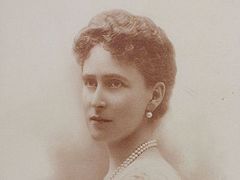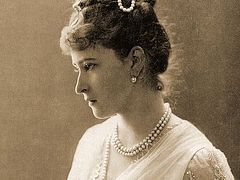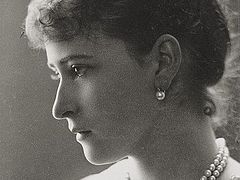Letters have always been a mirror to the hearts of the saints, especially when these letters are addressed to people close to them. It’s where they reveal their inner spiritual struggles with a holy vulnerability that shows how one’s path in Christ is experienced.
Elizabeth’s correspondence with Tsar Nicholas is very revealing. There survive some 100 letters and cards written by her to her brother-in-law. They had been exchanging letters for a long time, ever since their lives intertwined through marriage, and what is remarkable is her confessional tone. She opens her heart to Nicholas and discusses God with him, and—although it is not surprising—I still cannot fail to be struck by how modest and humble she is. In one letter from April 1909 she writes Nicholas “I can be disappointed in myself but then I also have no illusion and don’t imagine I am different to others. I want to work for God and in God for suffering mankind”. Her tone is often self-admonitory, as she admits what she sees as her flaws and failings, but in this she also but also reveals the essence of herself, showing that she is someone who is ever striving to better herself before God.
What also becomes clear from Elizabeth’s letters to Nicholas is how much she values him as a correspondent. She wants to reveal her motivations to him, but also, I think she finds she can explore herself through opening up to him, so that her letters become both explanatory and exploratory in tone. For example, in another letter from April 1909, she writes:
“I took up the life I am now leading not as a cross—but as a road full of light God showed me after Serge’s death and which years and years before had begun in my soul. I can’t tell you when—it seems to me often that already as a child there was a longing to help those that suffer.”
She also looks to Nicholas for approval, and this is evident in a letter she wrote him in 1910 before she was made Abbess of her convent. She says: “Pray for me dear, I am going deeper into our Orthodox Church and becoming a missionary of Christian faith and charity work and, oh dear, I am so unworthy of it all and I do so want blessings and prayers.” And then, just a few days later, she writes: “Dearest brother dear, I ask your blessing, prayers and forgiveness before the solemn day I am approaching. Please please be convinced that however awkward or sinful my poor earthly life may go, I am a true subject of yours—the will is always full of good intentions and religious wishes even if on the way I stumble and make endless mistakes.”
The founding tenets of the Convent were very particular to Elizabeth’s vision for her religious institution and informed the way it operated. Considering work to be the basis of all religious life and prayer to be its reward, the Grand Duchess wanted her nuns and the work of her Convent to alleviate the suffering of the sick, poor and ill-educated. Consequently, on taking the veil, her Sisters would not renounce completely all earthly life and contact with secular society. Hence, the operation of the hospital and dental clinic incorporated into the Convent was fully supported by the Sisters and the Mother Superior herself.
The day began at 6 am at the convent and the routine followed monastic practice. After common morning prayers in the hospital church, the Grand Duchess gave the sisters instructions for the working day. At midday, during the meal, one of the sisters read from the Lives of Saints; at five in the evening was Vespers followed by Matins, and at nine, evening prayers were read in the hospital church, following which the Sisters received a blessing from their Mother Superior and retired to their cells for the night.
As Mother Superior, Elizabeth led an ascetic life. She fasted rigorously and existed only on a diet of milk, eggs and vegetables and bread. She arose at midnight to pray in her chapel or to visit the hospital ward, frequently staying at the bedside of a patient in pain or fear, doing everything she could to soothe their anguish.
Occupying only three rooms in the Convent—a study, sitting room and bedroom—Elizabeth denied herself all that had been plentiful in her previous life as a Grand Duchess. Her quarters were painted white and adorned only with icons, while her furniture was sparse and simple.
Elizabeth achieved a super-human amount of work, seamlessly threading it into her day. She undertook the hardest tasks herself, never asking her Sisters for help or expecting them to shoulder her workload in any way. Every day she had to examine countless petitions and letters from all corners of the country and she received many visitors from all backgrounds, to each of whom she gave her time and assiduous attention. In the hospital she assumed the most taxing and skilled roles, assisting at operations and surgical dressings as well as nursing, but also devoting precious hours to sitting at the bedside of those in need of spiritual succor.
A selection of previously unpublished letters of Saint Elizabeth to Tsar Nicholas, edited by Sophie Law, is included in the book The Romanov Royal Martyrs: What Silence Could Not Conceal.
***
About the author:
Sophie Law read Greats at Merton College, Oxford University, before building upon four years of Russian with a Masters in Russian Studies from the School of Slavonic & East European Studies, UCL. She has published in collaboration with Fabergé her debut novel in October 2018, entitled Olga’s Egg, which offers every narrative jewel possible to enthrall the reader. We travel from London to St. Petersburg and back again in search of the lost Faberge eggs made for Grand Duchess Olga Nikolaevna, the eldest daughter of Tsar Nicholas II. Sophie, also, contributed to “The Romanov Royal Martyrs Project” by working on the chapter on Holy Martyr Grand Duchess Elizabeth Feodorovna's monastic life and a selection of letters by her to the Tsar-Martyr Nicholas II.







